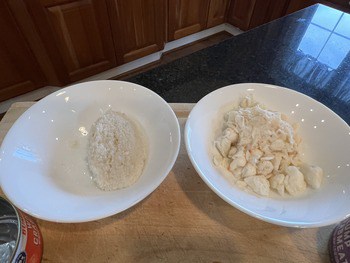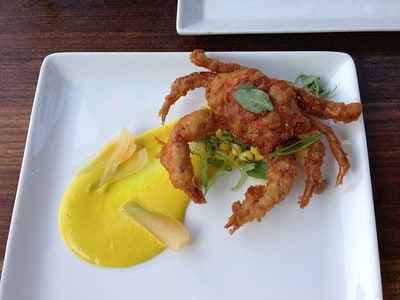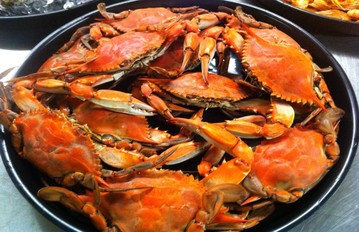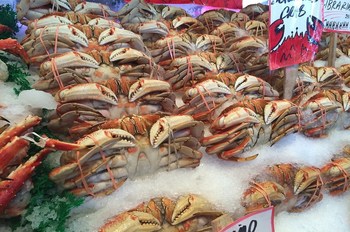Why are Crabs Cooked Alive (Is it really necessary?)
If you’re like me, you’ve stopped and wondered why we cook Blue Crabs, Dungeness Crabs, and other types of shellfish alive. It’s something I’ve grown up with, and never really stopped and wondered about until now. So, I did some research and came to a conclusion:
Because crabs are bottom feeders, they tend to harbor large amounts of pathogens which cause their meat to deteriorate quickly after death. To give this bacteria as little time as possible to negatively affect the meat, it’s common practice to cook crabs alive or shortly after death.
If you have ever been to a crab feast and eaten an odd-tasting crab, this is probably the reason why. You don’t want to eat a crab that died long before being cooked, because the bacteria on its shell caused the meat to go bad.
However, I can’t help but wonder if there is a more humane way to go about this. I know some people who won’t eat crabs because of this cooking practice. So, let’s go over how to get around cooking crabs alive and still have quality crab meat.
Disclaimer: This article goes into detail about cooking and de-shelling crabs. Some readers may find this information unsettling.
First, understand what happens when you cook crabs.
A study by the Journal of Aquatic Food Product Technology thoroughly explains the process of cooking crabs. They found that by either steaming or boiling the crab, they are exposed to temperatures of 250 degrees Fahrenheit.
Crabs are exposed to around 250° F for 8 to 15 minutes.
This temperature varies depending on the cooking process. With steaming, the heat is equally distributed throughout the entire pot for the duration of the cook. Boiling, on the other hand, the temperature slowly rises throughout the cook and is colder at the top of the pot. I have an article on the pros and cons of boiling crabs you can read here.
Because of this slow rise in heat, we can assume that crabs live for a longer period of time in the pot when they are boiled instead of steamed. Steaming crabs expose them to consently high temperatures throughout the cook, resulting in a quicker death.
More studies need to be done on how long crabs live for after they are put in the pot. A few estimates say that crabs will live for at most 5 minutes after they are put in a pot. This can be as low as 3 minutes if you are steaming a crab rather than boiling it. Crabs may shed their claws while being cooked alive due to the stress involved.
Cooking affects the meat’s texture and color.
Cooking the crab makes it meat harden. When the crab cools, this hardened meat separates from the shell.. This makes picking the crab much easier if you wait a bit after cooking. It’s also much easier to pick a crab when it isn’t too hot to touch.
Interestingly enough, the same study found the longer you cook crabs, the less meat you end up with. It found that crabs cooked for 8 minutes yielded more meat than those cooked for 10 to 12 minutes. It turns out that boiling crabs yielded more meat than steaming because of the higher water content.
That does not mean that you should cook your crabs for the shortest amount of time possible! Cook your crabs for at least 10 minutes or until the shell is red. This is important to kill the harmful bacteria found ona crab’s shell, loosen the meat, and make the meat edible.
The cooking process also makes the meat change into the classic taste and color of crab meat that you’re used to. If you didn’t cook the crab, you wouldn’t recognize the meat.
Cooking the crab destroys the many bacteria that lives on its shell.
The most important part of the cooking process is making the crab safe to eat. Crabs are bottom feeders, which means they harbor large amounts of harmful bacteria on theirs shells. This is what causes a crab to go bad shortly after it dies.
When cooked at high temeratures, in this case 250° Fahrenehit, the majority of the bacteria is killed and makes the crab safe to eat.
Three Humane Ways to Cook Crabs.
The RSPCA knowledge base defines “killing an animal” as loss of sensibility (ability to feel pain), followed by death. The animal must experience an immediate loss of sensibility or insensibility induced without discomfort or pain (Source). With this information, I’ve found two ways to put crabs in a desensitized state to humanely cook them.
Try “Spiking” the crabs.
Spiking the crabs is the most humane, study-backed method of killing crabs. It’s a term for inserting a sharp object (usually a knife) into a part of a crab’s body with large nerve clusters. This action instantly kills the crab with the least pain possible.
The largest nerve cluster on the crab is under its abdomen, which is the little flap you lift on the underside of a crab. To “spike a crab,” place it on a cutting board on its shell. Within a span of 10 seconds, lifts its abdomen and firmly insert knife through its shell. This will swifly and painlessly kill the crab.

From here, you can steam, boil, or cook the crab however you like. I would recommend you pair this method with submerging the crabs in ice water. This slows the crab, making it easier to handle. I’ll go over this method next.
Submerge the crabs in ice water for 10 minutes.
A practice that’s growing in popularity among crabbers is submerging your crabs in ice water before cooking them. This will put the crabs in a dormant state, which makes them easier to handle and is a humane way of cooking crabs.
I recommend that you fill a cooler of ice water. The more ice, the better. If you need an idea of how large of a cooler you need, I have a size chart that tells you the cooler size you need for different numbers of crabs. You can read that here.
Once you fill a cooler with ice water, pour the crabs in. You may have to do this in several batches, depending on how many crabs you have and the size of the cooler. Over the next 10 minutes, the crabs will go into a dormant state from the cold water.
Afterward, the crabs will be easy to handle and place in the steamer. People have reported that these crabs are less likely to lose their limbs when steamed, which is a common issue when cooking crabs. I can only assume this is the same case for boiling crabs.
These crabs are desensitized from the cold water, which by definition of the RSPCA mentioned earlier, makes them humanely killed.
One issue that comes from this process is that you may end up cooking a dead crab. After you ice the crabs, you may have one die from the icing process or the crab may have been dead beforehand. After you ice the crabs, they all seem dead. It is more time-consuming, but it may make sense to put each crab in the ice water one at a time to avoid icing an already dead crab. These will be unsafe to eat.
Clean, or strip the crab’s shell & guts before cooking.
A second option for humanely cooking crabs is to clean them before cooking. This process includes removing the parts of a crab you do not eat such as the carapace, gills, and guts. This is a more popular practice in Southern USA.

I recommend you watch the Thundermist Lure video below for a brief tutorial on how to clean a crab. He goes over how to kill the crab and clean it step-by-step.
Downsides of cleaning crabs before cooking:
I personally do not recommend this option, but that’s my personal bias. It’s the more quick and painless way of cooking crabs, which makes it the most humane. The reason why I do not like it is because this process removes the crab’s “mustard” found in outs outer shell. It’s a popular part of a crab to eat here in Maryland. If you’re curious about what the crab’s mustard is, read this article where I explain.
Another downside to cleaning crabs is the chance that a crab might go bad. If you clean your crabs directly before cooking them, you won’t run into this issue. Never clean your crabs and leave them out for an extended period before cooking them. You should always cook your crabs directly after cleaning them.
Benefits of cleaning crabs.
- Crabs that are cleaned of their shell, guts, and gills before they are cooked will keep their claws when cooked. Crabs that are cooked alive will often lose their limbs due to the stress involved in the cooking process. Cleaned crabs are killed before cooking, so they stay intact.
- Cleaning crabs before cooking is more humane than cooking them alive. It involves an instantaneous death for crabs, unlike the slow death that a crab suffers when cooked alive.
Works Cited
- Brian E. Farkas , S. Andrew Hale & Mascha A. Overboom (1999)An Improved Process for Retort Cooking Atlantic Blue Crab, Journal of Aquatic Food Product Technology, 8:4, 85-96, DOI: 10.1300/J030v08n04_08
- RSPCA KNOWLEDGEBASE. RSPCA Knowledgebase. (2018, November 9). Retrieved August 26, 2022, from https://kb.rspca.org.au/knowledge-base/what-is-the-most-humane-way-to-kill-crustaceans-for-human-consumption
- Queen’s University Belfast. (2013, January 16). ‘Shell-shocked’ crabs can feel pain. ScienceDaily. Retrieved August 25, 2022 from www.sciencedaily.com/releases/2013/01/130116195336.html/





